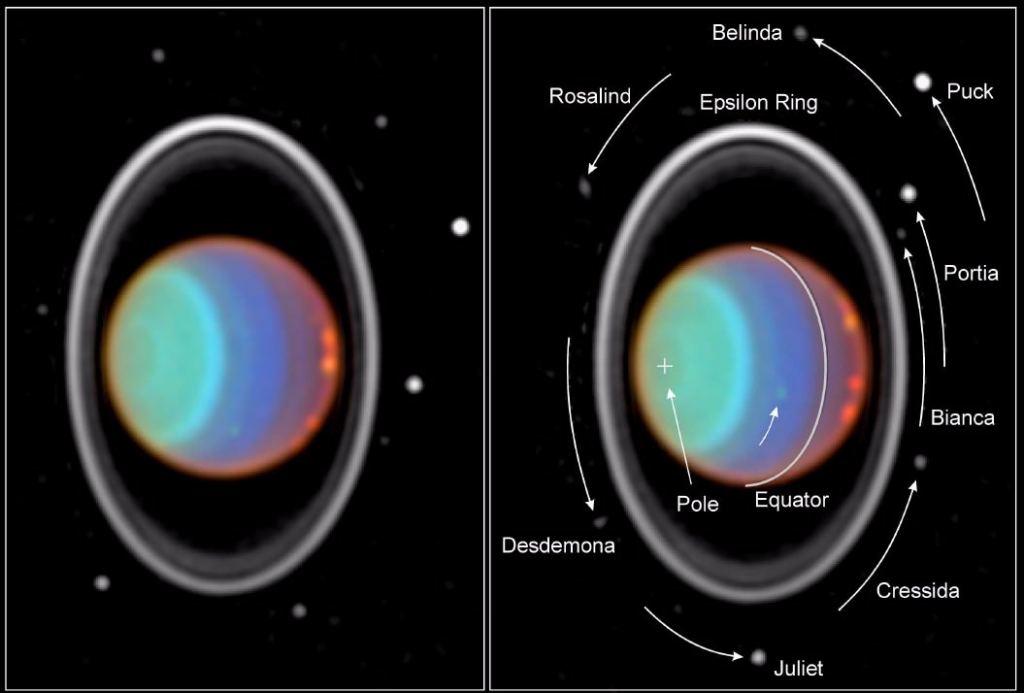Exploration of ocean worlds has become a hot topic of late, primarily due to their role as a potential harbor for alien life. Moons that have confirmed subsurface oceans garner much of the attention, such as Enceladus and Europa. But they may not be the only ones. Uranus' larger moons - Miranda, Ariel, and Umbriel could potentially also have subsurface oceans even farther out into the solar system. We just haven't sent any instruments close enough to be able to check. Now a team led by Dr. Corey Cochrane at NASA's Jet Propulsion laboratory has done some preliminary work to show that a relatively simple flyby of the Uranian system with an averagely sensitive magnetometer could provide the data needed to determine if those larger moons harbor subsurface oceans. This work is another step down the path of expanding what we think of as habitable environments in the solar system.
This isn't the first time that the Uranian system has come up as potentially harboring ocean worlds. Back in December a team from MIT calculated that the magnetic fields Uranus induces on its moons are strong enough to detect the presence of subsurface oceans. What's more - the uniqueness of the Uranian system could even allow magnetic data to show the ocean's depth, thickness, and salinity.
Such detailed measurements weren't possible with Galileo, a probe equipped with a magnetometer that visited the Jupiter system. Jupiter's magnetic field is relatively static and symmetric, meaning its moons aren't bombarded with differing field strengths based on their orbital path.
Uranus, on the other hand, is unique in a number of ways, not the least of which is its non-symmetric magnetic field. It is tilted 59° from the spin axis of the planet, and the center of the field is off-set from the center of the planet itself. So when the planet's moons go through their orbits, they are constantly subjected to varying magnetic fields. A moon's reactions to that varying field are exactly the kind of data scientists would need to collect to determine if there is a subsurface ocean on the moon or not.
Some moons already have features that point to that possibility. Miranda has " coronae ", which are ridges that appear to be caused by geological activity. While some models show that any ocean that once existed on Miranda would have long ago frozen, there are hints at the presence of volatile clathrates, a type of chemical that makes it harder for ice to form, delaying that freezing process. Those clathrates have been found on other moons already, so their presence on Miranda or other Uranian moons can't be discounted.
Whether or not there are actually oceans underneath the surface of any of Uranus' moons, the system is still worth a second look. And the only window in the next 25 years to take that look is opening up at the end of the decade. Any mission that would launch by then would still take more than a decade to arrive, though there still remains much work to be done before such a mission could even be considered.
UT video discussing the feasibility of a mission to visit the ice giants.Dr. Cochrane and his team chipped away at some of that work with their new paper. They calculated what a variety of expected field strengths could mean for the depth of both any subsurface ocean and also the ice shell over it. In addition, they calculated values for the salinity of any existing ocean, as well as any noise that might be caused by the moon's ionosphere. Those ionospheric measurements could confound any readings of the oceans themselves, but the researchers believe that even with significant interference, valuable data on the presence and size of any such oceans should be collectible on a single fly-by for the three biggest moons - Miranda, Ariel, and Umbriel.
Even with these updated models, and the relative cost effectiveness of such a single fly-by mission, there are currently no concrete plans to send a probe to Uranus for the next launch window. Knowing that scientists can find such ground-breaking data relatively easily might be cause to reconsider that deficiency.
Learn More:
arXiv - In Search of Subsurface Oceans within the Uranian Moons
Eos - Do Uranus’s Moons Have Subsurface Oceans?
UT - The Moons of Uranus Are Fascinating Enough On Their Own That We Should Send a Flagship Mission Out There
UT - How Many Moons Does Uranus Have?
Lead Image:
Highest resolution image we have of Miranda, one of Uranus' most interesting moons.
Credit: NASA
 Universe Today
Universe Today


